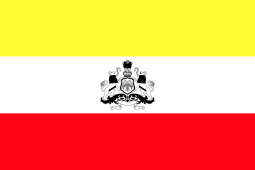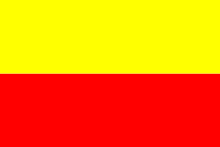Flag of Karnataka
 | |
| Use |
Civil and state flag |
|---|---|
| Proportion | 2:3 |
| Adopted | 8 March 2018 |
The Flag of Karnataka is the flag of the State of Karnataka in southern India.
Official adoption
The current version was officially designed during the Fourteenth Assembly and recognised by the state government of Karnataka on the 8th of March 2018. [1]. Though the flag has been officially recognized by the state's assembly, it is currently waiting for approval from the central government of India to become an official symbol of the state of Karnataka. [2]
Historical variants
| Version | Timeline |
|---|---|
| Mysore flag | 1399–1974 |
| Kannada flag (de facto) | 1974–2018 |
| Current version | 2018–present |
Evolution of designs
Flag of the Kingdom of Mysore (1399–1974)

The present-day Karnataka state went through a series of geopolitical and cultural transformations. After India's independence in 1947, the constitutional changes took nearly three years to come into effect, during when Mysore Kingdom remained the state's original form territorially. In 1950, the Kingdom of Mysore was renamed Mysore State when India became a democratic republic, but Maharaja Jayachamarajendra Wadiyar continued to be the chief head of Mysore State (as maharaja, then as rajpramukh, and finally as governor). In 1956, the Reorganisation of States Act on Linguistic-Basis was passed by the Union of India, which furthered Mysore State's frontiers. Coastal parts of Mangalore, which belonged to Madras Presidency, were incorporated into Mysore State, as well as Kannada-speaking regions of Bombay (sometimes referred to as Bombay Karnataka region) and Hyderabad (Hyderabad Karnataka). In 1974, Mysore State was renamed Karnataka State. Until this point, the flag of the Kingdom of Mysore remained the state's flag, official until 1956, and de-facto thereafter, until 1974, alongside the bi-coloured Kannada Paksha flag. With the state's renaming, pro-Kannada movements throughout Karnataka gained pace, during when the bi-coloured Kannada flag became more prevalent.
The Mysore Kingdom flag was oblong and bi-coloured: a red strip on the top, symbolising vermilion, and a maroon strip on the bottom. In the centre was inscribed the coat of arms of the Kingdom of Mysore. Some synonymous versions of the flag redact the emblem; the original version, however, comes with it inscribed in the centre. The coat of the arms bears a mythical two-headed eagle, called gandaberunda, in Kannada. This emblem itself was an adoption from that of the Vijayanagara Empire. Mysore Kingdom inherited this right after the principality was commissioned in 1399 by Harihara II, anointing Mysore Kingdom's first ruler, Yaduraya, as its ruler.
After the state's renaming in 1974, this flag was gradually decommissioned. Nevertheless, this flag remains, to this day, the official flag of the Mysore Royal Family, and is used during the private and, sometimes, in public, celebrations of the Dasara festival, including the Special Assembly (haas durbar) during the carnival.
Kannada Paksha flag (1974–2018)

While the bi-coloured Kannada Paksha flag remained the state's de-facto flag, the legal complications were quite complex. The bi-coloured flag is the official flag of a state political party called Kannada Paksha. It would be an advertisement of the party if the state recognised this flag as its own official one. However, the flag itself was designed and became prevalent during pro-Kannada movements in the late 1960s. Therefore, the bi-coloured flag became more sentimentally attached to the people and Kannada speakers and literati.
When in 2018, Chief Minister Siddaramaiah's government officially recognised the latest version, the party leader Vatal Nagaraj expressed his disapproval. [3]
Latest design (2018–present)
In India, only Jammu and Kashmir is allowed to have a state flag. However, after a delegation from the noted Kannada writer and journalist Patil Puttappa, and Bheemappa Gundappa Gadada, a social worker, met him, Chief Minister Siddaramaiah constituted in June 2017 a panel of nine legal experts, scholars, and Kannada literati, headed by G S Siddaramaya, Principal Secretary of the Department of Kannada and Culture, to study the legality and judicial implications of the formal adoption of a flag for the state. [4]
After the committee submitted a report, a team of designers was instituted, which came up with the latest version that is now in effect. [5] The current version is a symbolic confluence of the Indian flag—with tri-colour strips—and the old Karnataka flag, as well as the state's coat of arms charged in the centre of the flag, which, in majority, is a derivation of the coat of arms of the Kingdom of Mysore. [6] The design was met with opposition from pro-Kannada political parties and groups, arguing that the old (Kannada Paksha) flag was more representative of the state than the new one. [3]
The current version of the flag was recognised by Chief Minister Siddaramaiah by unveiling it on 8 March 2018, awaiting the central government's approval of the state-recognised flag.
See also
References
- ↑ "Karnataka flag unveiled: Yellow, white and red with state emblem in the middle". The News Minute. 2018-03-08. Retrieved 2018-03-08.
- ↑ https://qrius.com/karnataka-unveils-new-state-flag-pending-centres-approval/
- 1 2 "Cannot Accept Proposed Karnataka Flag Design, Says Pro-Kannada Group Leader". News18. Retrieved 2018-03-08.
- ↑ "Panel Recommends Separate Flag For Karnataka". NDTV.com. Retrieved 2018-03-08.
- ↑ "Karnataka panel proposes 3-colour official state flag". The Indian Express. 2018-02-08. Retrieved 2018-03-08.
- ↑ "State flag may be a tricolour with Karnataka emblem on white - Times of India". The Times of India. Retrieved 2018-03-08.